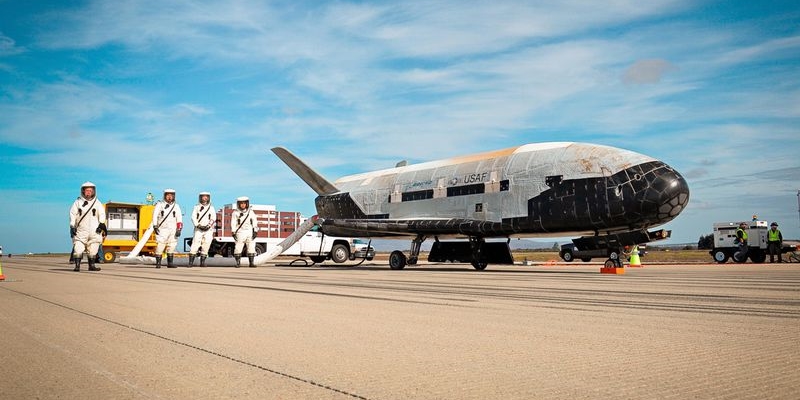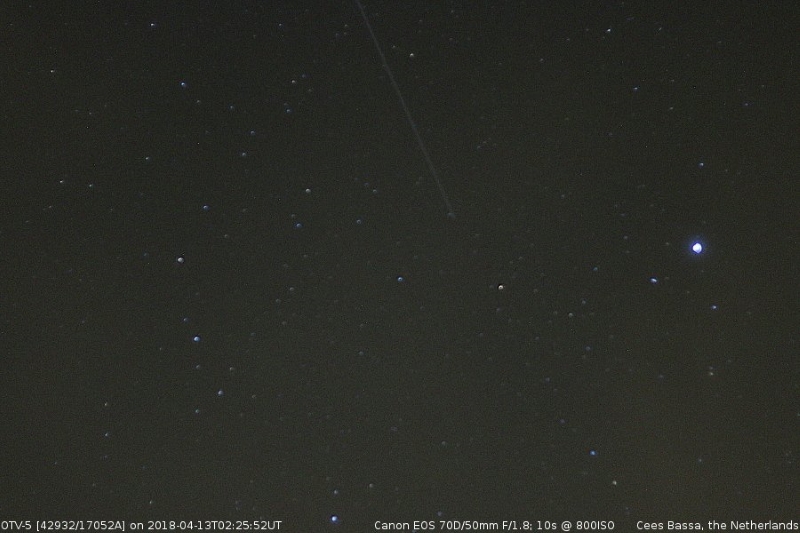In September 2017, the secret American military apparatus X-37B went into space. The parameters of its orbit were not published in the public TLE list (display format of the orbit elements in two lines) from NORAD, but after a few months, space enthusiasts were able to find it.
 X-37B after landing, photo Boeing
X-37B after landing, photo BoeingOn September 7, 2017, the X-37B went into space for the fifth time, for the first time on the Falcon 9 rocket. In the
broadcast, SpaceX, as is usually the case for military secret loads, showed only the work and landing of the first stage. The spaceplane’s payload and the parameters of its orbit were not published, the only thing that became known was that the device was put into orbit with a higher inclination than in previous flights. The state space control systems of the USA, Russia and China most likely discovered X-37B for a maximum of several days, but they did not consider it necessary to report anything to the general public. And astronautics enthusiasts began their hunt.
 Possible view of the X-37B in orbit, the image of Boeing
Possible view of the X-37B in orbit, the image of BoeingOpen data didn't help much. The danger zones, which are announced to the whole world before the launch of the rocket, suggested an inclination in the region of 43 °. After separation of the payload, the second stage slowed down and descended from orbit, NOTAM (warning of a dangerous area) to its region of incidence south of Australia assumed an inclination of 60-70 °, therefore, the stage seriously maneuvered. The parameters of the orbit were really new - if in previous flights the amateurs found the device for several days, this time the initial observations did not bring success.
The first clue was the observation of the Scottish astronomer Russell Eberst (Russell Eberst). On October 3, he
noticed an object with an orbit height of 350 to 450 km and an inclination of 55 °. But the accuracy of the observations was insufficient, and on subsequent turns of the X-37B was not found. In November, there was news about another observation, but it turned out to be a false trace, and the search took a few more months.
On April 11, a professional radio astronomer, observing satellites as a hobby, Cees Bassa (Cees Bassa)
discovered a new object with an inclination of 54.5 ° and an orbit height of 355 km.
 OTV-5 mission orbit compared to previous ones, Dr Marco Langbroek / JSatTrack scheme
OTV-5 mission orbit compared to previous ones, Dr Marco Langbroek / JSatTrack schemeThe accuracy of the observation was sufficient for the object to be
seen by amateur astronomer Ted Molczan (Ted Molczan) and calculated his TLE. And finally, Siz Bassa was able to find and photograph a mysterious object.
 Photo source - Twitter Siza
Photo source - Twitter SizaWhy is the detected object most likely the same X-37B?
 Reconstruction of the orbit at the time of launch, Dr Marco Langbroek / JSatTrack schemeFirst of all
Reconstruction of the orbit at the time of launch, Dr Marco Langbroek / JSatTrack schemeFirst of all , knowing the parameters of the orbit, you can "scroll" it in time back and forth. And if you look at the orbit at the time of launch on September 7, its plane passes through Cape Canaveral. Of course, this method does not give one hundred percent reliability - if the apparatus changed the orbit, then due to a change in the orbital period, the plane could be anywhere, but the coincidence looks very good.
Secondly , the altitude of 355 km is a rather low orbit, it is lower than the ISS. The deceleration from the remnants of the atmosphere is quite noticeable here, even the ISS is one hundred kilometers higher forced to regularly turn on engines to raise its orbit. Random debris at such a height is likely to quickly brake and burn, but a heavy device that supports orientation to minimize the cross-sectional area will be able to stay there long enough. Also for this orbit it is impossible to pick up an ordinary satellite from the known ones. And the height of the orbit is not much different from previous flights of the X-37B - OTV-1 flew at an altitude of about 330 km, OTV-2 “jumped” between 270 and 450, OTV-3 was at an altitude of 390 km, and OTV-4 - 350.
And finally , the apparent brightness of the object coincides with previous observations of the X-37B.
The only officially announced X-37B payload in the fifth flight is an experiment by the US Air Force Research Laboratory — an “advanced thermal expander built into the design” —a technology for an easier and cheaper spacecraft thermal control system. It is logical to assume that the test of such a system will last a long time, and OTV-5 can beat the duration of the previous flight of 718 days. It also happens that the X-37B takes small satellites with it, but so far no new objects from the 2017-052 launch have appeared in the catalog. So, in anticipation of the news, it remains to hope for enthusiasts - only they can publish, for example, a photograph of the apparatus in flight, if they manage to photograph it.
PS But Zuma, most likely, really burned in the atmosphere. At least the enthusiasts found nothing.